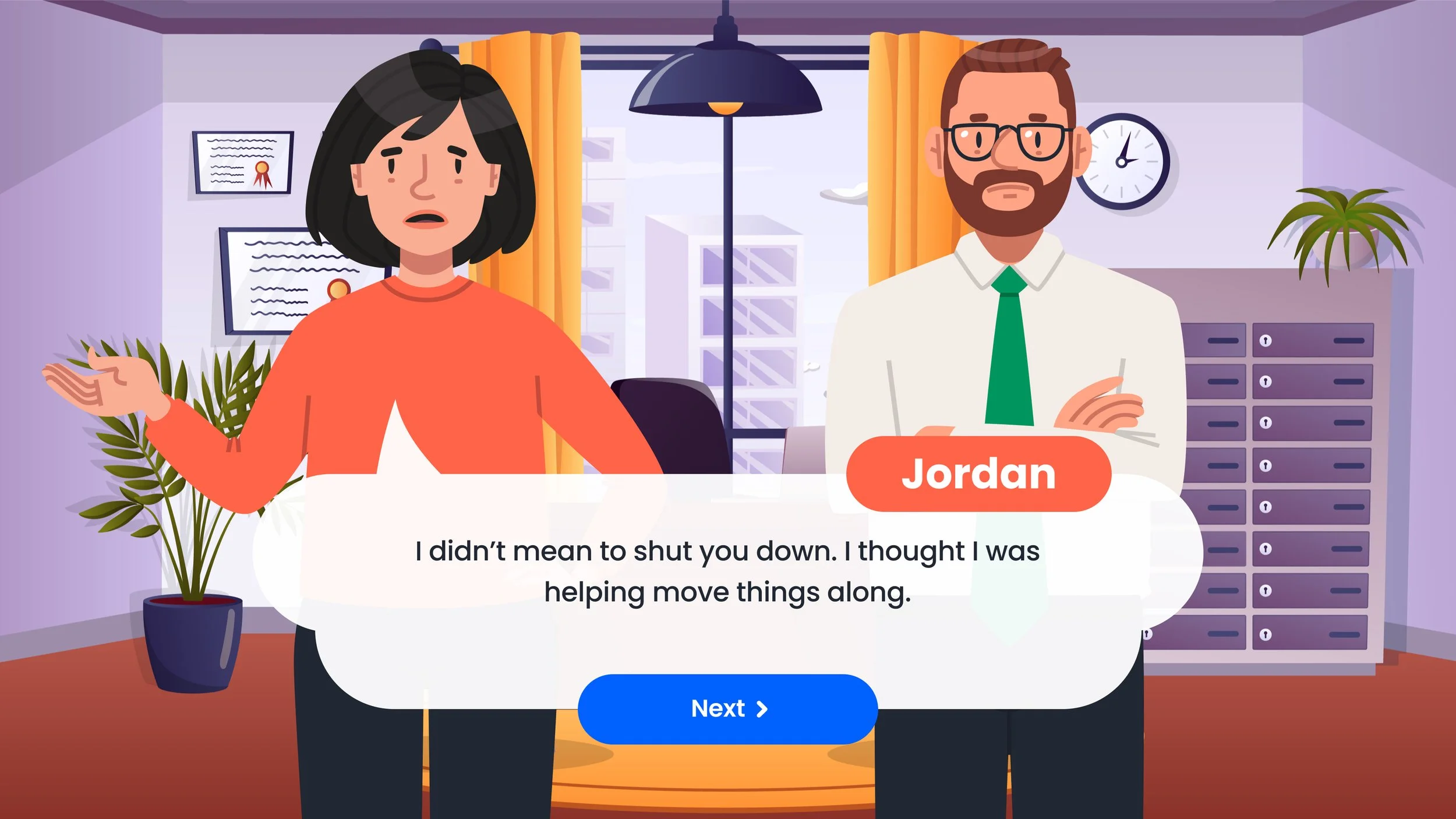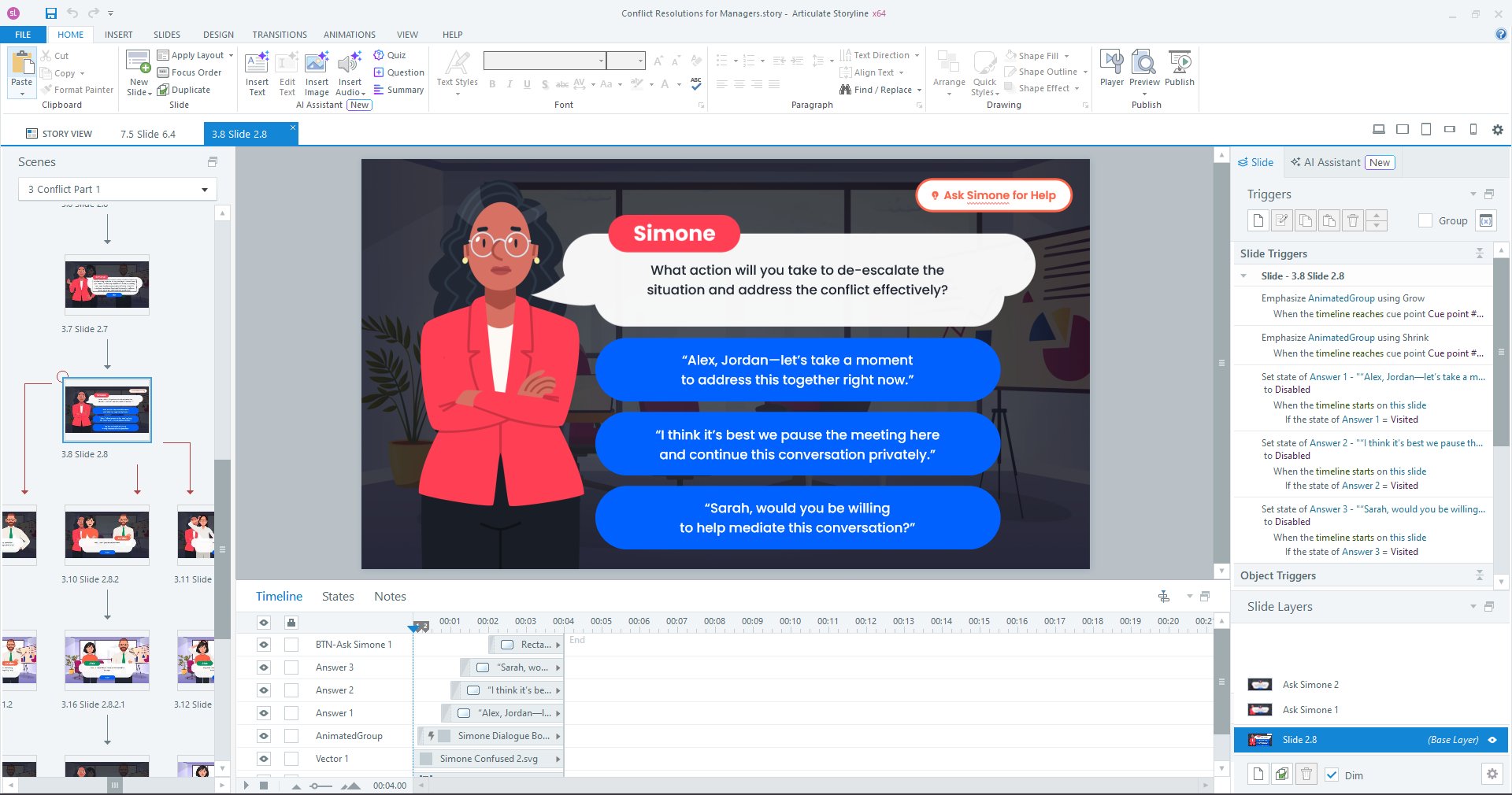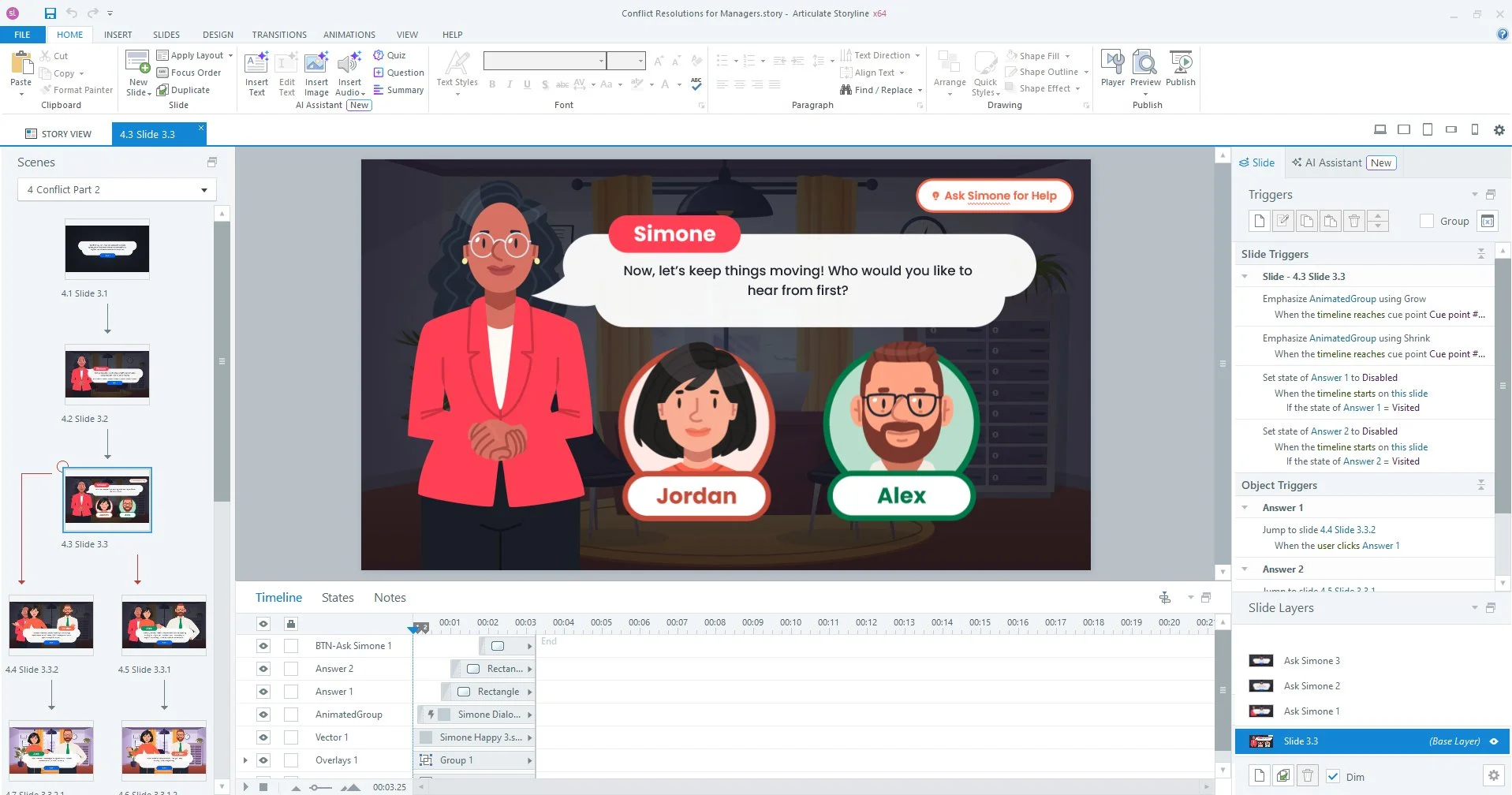
This scenario-based e-learning course equips managers to navigate workplace conflict with confidence by practicing effective communication through interactive decision points and realistic dialogue.
Conflict Resolution for Managers
Responsibilities
Visual Design, e-Learning Development, Action Mapping, Storyboarding, Prototyping
Software Used
Figma, FigJam, Adobe Illustrator, Articulate Storyline
AI Used
ChatGPT
Duration
3 weeks
This whole idea started with my fiancé…
Even before he officially became a manager at the company he works for, he always had those manager instincts. He’d get off from work and vent, not about his own responsibilities, but about how other managers were handling tough conversations with his coworkers. And over time, a pattern became clear: most managers weren’t equipped to handle conflict well. Some avoided it entirely, while others jumped in without really listening. Either way, it made things worse.
That stuck with me, especially because I saw the same thing happen at previous companies I worked for. Team conflict isn’t rare. And when it’s left unresolved, it doesn’t just create tension; it chips away at morale, slows down collaboration, and makes everything harder than it needs to be. I started imagining a course for people like my fiancé: new or soon-to-be managers who already carry leadership instincts, but don’t have the time or patience for long, boring eLearnings. Something that was clear, quick, and engaging.
Defining the Business Problem
Poorly handled conflict damages morale, slows collaboration, increases turnover risk, and often drives high-potential employees out of organizations. Traditional learning solutions (like HR manuals or passive compliance videos) weren’t enough to prepare managers for the nuance of real-time, emotional conversations. Managers needed more than information; they needed a space to practice decision-making and communication strategies in realistic conflict scenarios.
Choosing the Right Learning Approach
To build true confidence, managers had to experience consequences for their choices in a safe, low-risk environment.
A scenario-based learning experience was the best fit.
1. It allowed managers to practice private conversations with team members.
2. It exposed them to natural emotional reactions based on their choices.
3. It created a low-stakes environment for practicing listening, de-escalating, and problem-solving without fear of real-world fallout.
Tool Chosen: Articulate Storyline (for full control over branching dialogue, accessibility support, and emotional tone design).
My Process
I mapped the business goal, learner barriers, and target behavior using an alignment map. The core action managers needed to practice was initiating private, empathetic conversations.
01. Defining the Goal
I created a branching storyboard and visual system that prioritized emotional clarity, clean UI, and intuitive learner pacing without relying on voiceover.
02. Designing the Solution
I built the course in Articulate Storyline, layering triggers and visual cues to create a seamless, learner-centered scenario experience.
03. Developing the Experience
Defining the Goal
I wanted this course to do more than just “raise awareness.” It needed to support real behavior change that managers could act on immediately without feeling like they were sitting through another forgettable training.
Using Cathy Moore’s Action Mapping, I focused the experience around a measurable outcome:
→ Reduce team conflict-related disruptions by 20% within six months.
From that goal, I identified two key actions that managers needed to build habits around:
Key Actions
Equip new and mid-level managers to de-escalate team conflict by applying structured conversation techniques in real-time, emotionally charged situations.
When team conflict surfaces in a public setting, managers will redirect the conversation to a private space, facilitate a calm dialogue between employees, and guide them toward identifying and resolving the root issue without escalating the tension.
To target the real-world behavior, I built a branching scenario that simulates a public team conflict in progress.
Learner Role
You’re a manager observing tension between two employees. Your goal?
→ De-escalate the situation in public
→ Redirect the conversation to a private space
→ Facilitate a calm dialogue to uncover the root issue
What makes this realistic:
→ Each decision point impacts how the employees react
→ Emotional tone, phrasing, and timing all affect the outcome
→ Feedback is immediate: poor choices escalate the tension; better choices model effective manager responses
This simulates real-world pressure. Learners get safe, repeatable practice applying conversation techniques in high-stakes situations, without risking team trust.
Storyboarding the Learner Experience
Before moving into visual design and development, I created a text-based storyboard to map the learner journey. This storyboard outlined dialogue branches, decision points, emotional cues, and feedback layers, ensuring every moment tied back to the two core actions identified in the Action Map.
Storyboarding helped me visualize how learners would move through different conflict scenarios, what emotional shifts they would encounter, and how their choices would impact the conversations' outcomes.
By front-loading this structure, I was able to keep the final course focused, purposeful, and easy to navigate, helping managers practice nuanced communication skills in a clear, low-stakes environment.
Designing the Solution
Once I had the learning strategy locked in, I started storyboarding the course to simulate a realistic, choose-your-own-path conversation. I wanted it to feel more like a real coaching moment, not a forced role-play. Also, making sure to be aware of that this is a great learning opportunity for new or current managers and to have a mentor to help them through the conflict the learner will encounter in the course.
Moodboard
I took a lot of inspiration from visual novel/role-playing games (and just games in general). I wanted to take that role-playing aspect like they do in these games, and apply it to a learning experience. With a branching-scenario-based learning, I thought it would be the perfect solution and combination of engaging and immersion.
Some of the biggest inspirations I took was from games like Animal Crossing New Horizons, Doki-Doki Literature Club, and Honkai Star Rail.
Design Assets
I started by creating the brand in Illustrator, something simple and fun that I could reuse for future projects. After finalizing the logo and color palette, I searched Freepik for characters and backgrounds that fit the style. I customized the characters with different expressions and body language to help signal whether a situation was going well or not so much.
With those visuals ready, I jumped into Figma to begin designing interface elements like buttons and dialogue boxes. I chose rounded corners to keep things soft and approachable, avoiding harsh lines that could make the experience feel more intense than it needed to. Since the backgrounds were already colorful, I used the brand colors sparingly to keep things balanced and easy on the eyes.








Building in Storyline
Since I built the visual design of each slide in Figma, I was easily able to export the assets that I needed from each slide (characters, backgrounds, dialogue boxes, etc) as SVG files and then build out buttons that I would need for each slide in Storyline.
To explain the more technical side of things, I was able to:
→ Layer triggers and branching dialogue paths to simulate real conversation flow
→ Create subtle animations and character scaling to emphasize active speakers
→ Build clear, intuitive navigation to keep the learner focused on decision-making without distraction
The goal was to create a seamless, emotionally intuitive experience that allowed managers to practice conversations without feeling overloaded.




Key Design Decisions
Every design choice was made intentionally to support learner engagement, emotional connection, and cognitive clarity.
Character Scaling to Indicate Focus:
The speaking character was subtly scaled up during dialogue to guide learner attention and reinforce conversational flow.
Button Language (Next vs. Continue):
"Next" indicated movement within the current conversation; "Continue" signaled a new scenario or major transition, helping learners intuitively track their progress.
Facial Expressions and Visual Cues:
Strong character expressions replaced the need for VO, helping learners interpret tone, tension, and emotional context purely through visuals and dialogue.
Final Thoughts & Reflection
If implemented in a real-world setting, this training would support new and mid-level managers in resolving interpersonal conflict before it escalates into team disruption or turnover
Business goal alignment
This learning experience is designed to reduce manager hesitation in conflict situations, ultimately improving team cohesion, retention, and performance.
Potential success metrics
→ Reduction in HR-reported peer escalations
→ Positive self-reported manager confidence in post-training surveys
→ Faster resolution of team disputes (tracked via manager feedback forms)
What I’d improve next
→ Add a short reflection tool at the end for managers to journal their own conflict resolution styles
→ Build in pre/post assessments to measure confidence shifts
→ Include a follow-up microlearning with alternate conflict scenarios for spaced practice
This project helped me strengthen my ability to simulate emotionally sensitive workplace scenarios while balancing accessibility, realism, and learner safety.
View My Other Projects
Developing Learning Experiences at Allegro Media Design
Created client-ready e-Learning solutions at Allegro Media Design that blended storytelling, interactivity, and brand-aligned visuals using Vyond animations and Articulate Storyline to deliver effective and engaging training content for diverse agency clients.
e-Learning Development · Visual Design · Content Design
Rise course that helps new hires confidently recognize red flags and report phishing attempts before it's too late
Designed a short, practical Rise course specifically crafted to help new hires and current employees confidently recognize common red flags and report phishing attempts through proper channels before it's too late and sensitive data is compromised.
Microlearning · Visual Design





